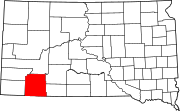Oglala, South Dakota
Oglala, South Dakota
Oglála | |
|---|---|
 Location in Oglala Lakota County and the state of South Dakota | |
| Coordinates: 43°10′59″N 102°44′13″W / 43.18306°N 102.73694°W | |
| Country | United States |
| State | South Dakota |
| County | Oglala Lakota |
| Area | |
| • Total | 13.4 sq mi (34.6 km2) |
| • Land | 12.5 sq mi (32.4 km2) |
| • Water | 0.9 sq mi (2.2 km2) |
| Elevation | 2,995 ft (913 m) |
| Population | |
| • Total | 1,290 |
| • Density | 103.2/sq mi (39.8/km2) |
| Time zone | UTC−7 (Mountain (MST)) |
| • Summer (DST) | UTC−6 (MDT) |
| ZIP code | 57764 |
| Area code | 605 |
| FIPS code | 46-46540[2] |
| GNIS feature ID | 1261129[3] |
Oglala (Lakota: Oglála;[4] "he scatters his own") is a census-designated place (CDP) in Oglala Lakota County, South Dakota, United States. The population was 1,290 at the 2010 census. Its location is northwest of the Pine Ridge Indian Reservation.
The community takes its name from the Oglala Lakota (also called the Oglala Sioux).[5]
Geography
Oglala is located at 43°10′59″N 102°44′13″W / 43.18306°N 102.73694°W (43.182978, -102.737078).[6]
According to the United States Census Bureau, the CDP has a total area of 13.4 square miles (35 km2), of which 12.5 square miles (32 km2) is land and 0.9 square miles (2.3 km2) (6.37%) is water. Oglala stands directly north of the Oglala Dam and its reservoir, Oglala Lake, completed in 1941.
Oglala has been assigned the ZIP code 57764.
Demographics
| Census | Pop. | Note | %± |
|---|---|---|---|
| 1990 | 422 | — | |
| 2000 | 1,229 | 191.2% | |
| 2010 | 1,290 | 5.0% | |
| U.S. Decennial Census | |||
As of the census[2] of 2000, there were 1,229 people, 229 households, and 201 families residing in the CDP. The population density was 98.3 people per square mile (38.0/km²). There were 279 housing units at an average density of 22.3 per square mile (8.6/km²). The racial makeup of the CDP was 0.73% White, 98.78% Native American, 0.08% Asian, 0.08% from other races, and 0.33% from two or more races. Hispanic or Latino of any race were 0.33% of the population.
There were 229 households out of which 53.7% had children under the age of 18 living with them, 34.1% were married couples living together, 41.5% had a female householder with no husband present, and 12.2% were non-families. 10.0% of all households were made up of individuals and 4.4% had someone living alone who was 65 years of age or older. The average household size was 5.31 and the average family size was 5.62.
In the CDP, the population was spread out with 47.8% under the age of 18, 10.6% from 18 to 24, 26.9% from 25 to 44, 9.9% from 45 to 64, and 4.9% who were 65 years of age or older. The median age was 19 years. For every 100 females, there were 96.6 males. For every 100 females age 18 and over, there were 92.8 males.
The median income for a household in the CDP was $17,300, and the median income for a family was $19,688. Males had a median income of $15,781 versus $20,781 for females. The per capita income for the CDP was $3,824. About 45.1% of families and 55.8% of the population were below the poverty line, including 64.1% of those under age 18 and 52.3% of those age 65 or over.
See also
References
- ^ "2010 Census Redistricting Data (Public Law 94-171) Summary File". American FactFinder. United States Census Bureau. Archived from the original on July 21, 2011. Retrieved 23 June 2012.
{{cite web}}: Unknown parameter|deadurl=ignored (|url-status=suggested) (help) - ^ a b "American FactFinder". United States Census Bureau. Archived from the original on September 11, 2013. Retrieved 2008-01-31.
{{cite web}}: Unknown parameter|deadurl=ignored (|url-status=suggested) (help) - ^ "US Board on Geographic Names". United States Geological Survey. 2007-10-25. Retrieved 2008-01-31.
- ^ Bright, William (2004). Native American Placenames of the United States. Norman, OK: University of Oklahoma Press. p. 344.
- ^ Federal Writers' Project (1940). South Dakota place-names, v.1-3. University of South Dakota. p. 52.
- ^ "US Gazetteer files: 2010, 2000, and 1990". United States Census Bureau. 2011-02-12. Retrieved 2011-04-23.

